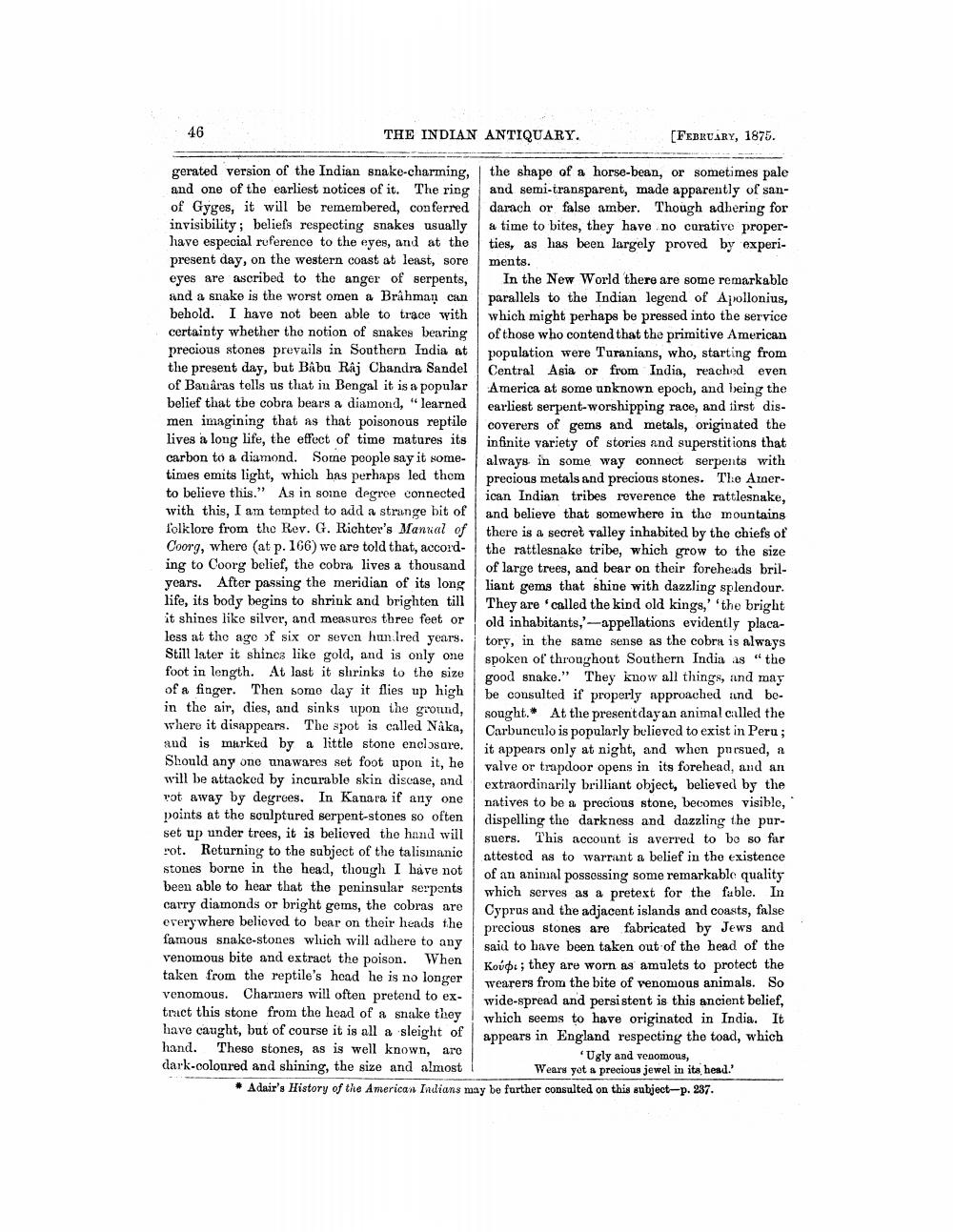________________
46
THE INDIAN ANTIQUARY.
[FEBRUARY, 1875.
the shape of a horse-bean, or sometimes pale and semi-transparent, made apparently of sandarach or false amber. Though adhering for a time to bites, they have no curative properties, as has been largely proved by experi
gerated version of the Indian snake-charming, and one of the earliest notices of it. The ring of Gyges, it will be remembered, conferred invisibility; beliefs respecting snakes usually have especial reference to the eyes, and at the present day, on the western coast at least, sore eyes are ascribed to the anger of serpents, and a snake is the worst omen a Brahman can behold. I have not been able to trace with certainty whether the notion of snakes bearing precious stones prevails in Southern India at the present day, but Babu Raj Chandra Sandel of Banaras tells us that in Bengal it is a popular belief that the cobra bears a diamond, "learned men imagining that as that poisonous reptile lives a long life, the effect of time matures its carbon to a diamond. Some people say it sometimes emits light, which has perhaps led them to believe this." As in some degree connected with this, I am tempted to add a strange bit of folklore from the Rev. G. Richter's Manual of Coorg, where (at p. 166) we are told that, according to Coorg belief, the cobra lives a thousand years. After passing the meridian of its long life, its body begins to shrink and brighten till it shines like silver, and measures three feet or less at the age of six or seven hun lred years. Still later it shines like gold, and is only one foot in length. At last it shrinks to the size of a finger. Then some day it flies up high in the air, dies, and sinks upon the ground, where it disappears. The spot is called Naka, and is marked by a little stone enclosure. Should any one unawares set foot upon it, he will be attacked by incurable skin disease, and rot away by degrees. In Kanara if any one points at the sculptured serpent-stones so often set up under trees, it is believed the hand will rot. Returning to the subject of the talismanic stones borne in the head, though I have not been able to hear that the peninsular serpents carry diamonds or bright gems, the cobras are everywhere believed to bear on their heads the famous snake-stones which will adhere to any venomous bite and extract the poison. When taken from the reptile's head he is no longer venomous. Charmers will often pretend to extract this stone from the head of a snake they have caught, but of course it is all a sleight of hand. These stones, as is well known, are dark-coloured and shining, the size and almost Adair's History of the American Indians may be further consulted on this subject-p. 237.
ments.
In the New World there are some remarkable parallels to the Indian legend of Apollonius, which might perhaps be pressed into the service of those who contend that the primitive American population were Turanians, who, starting from Central Asia or from India, reached even America at some unknown epoch, and being the earliest serpent-worshipping race, and first discoverers of gems and metals, originated the infinite variety of stories and superstitions that always in some way connect serpents with precious metals and precious stones. The American Indian tribes reverence the rattlesnake, and believe that somewhere in the mountains there is a secret valley inhabited by the chiefs of the rattlesnake tribe, which grow to the size of large trees, and bear on their foreheads brilliant gems that shine with dazzling splendour. They are called the kind old kings,' 'the bright old inhabitants,'-appellations evidently placatory, in the same sense as the cobra is always spoken of throughout Southern India as "the good snake." They know all things, and may be consulted if properly approached and besought. At the present day an animal called the Carbunculo is popularly believed to exist in Peru; it appears only at night, and when pursued, a valve or trapdoor opens in its forehead, and an extraordinarily brilliant object, believed by the natives to be a precious stone, becomes visible, dispelling the darkness and dazzling the pursuers. This account is averred to be so far attested as to warrant a belief in the existence of an animal possessing some remarkable quality which serves as a pretext for the fable. In Cyprus and the adjacent islands and coasts, false precious stones are fabricated by Jews and said to have been taken out of the head of the Koup; they are worn as amulets to protect the wearers from the bite of venomous animals. So wide-spread and persistent is this ancient belief, which seems to have originated in India. It appears in England respecting the toad, which 'Ugly and venomous, Wears yet a precious jewel in its head.'




